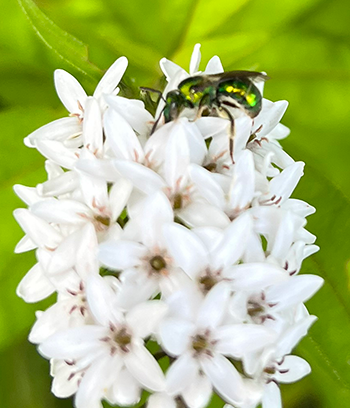 Bee Wise - Support Native Bees
Can you tell what kind of bee this is? Do you know if it is a native or introduced species?
The honeybee is well known and loved for its honey, but did you know that it is a non-native bee that was brought to North America by European colonial settlers? And, though more well known than our native species of bees and trucked around the country to pollinate crops, honeybees cannot efficiently pollinate many of our native plants such as blueberries and cranberries, and vegetable garden favorites such as tomatoes, squash, and pumpkins.

Maine is home to over 270 species of native bees. Some you'll recognize right away as bees, others look more wasp or ant-like. Here are just a few kinds of native bees to start you on your own bee wise discoveries:
-
Sweat Bees are small slender bees that are named due to their attraction to sweat. Some are a bright metallic green while others are dark brown or black. The nest in the ground and in rotten wood. Some are solitary while others are social.
-
Plasterer Bees Colletes are solitary ground nesters, whose nests may be grouped into colonies. The female lines the nest brood cells with a clear anti-fungal waterproof secretion applied with a unique bi-lobed tongue. This clear lining gives the bee its three common names: "plasterer," "cellophane," and "polyester" bee.
-
Masked Bees Hylaeus are known as the "masked" bees. The have a yellow or white facial markings - the male's mask being larger than the female's. This bee is small and slender with a matte black almost hairless body. On first glance they look like a tiny wasp. They are solitary and nest in the hollow center of pithy plant stems.
-
Miner Bees Andrena nest in the ground. They are dark colored with a usually shiny teardrop-shaped abdomen. They emerge early in the spring.
-
Bumble Bees may live underground or above depending on species, and some have no preference. This social bee is large and hairy with a corbicula, or "pollen basket", on each hind leg. Sixteen species of bumble bees live in Maine. They are important pollinators of fruit and vegetable crops. They will visit flowers on cold rainy days when other bees are inactive.
|

Native bees are not as numerous as they once were and should be for a healthy environment, and for the productivity of our gardens and crops. You can help by improving your yard with healthy habitat for bees:
- Grow a diversity of native plants, flowering shrubs and fruit trees that will provide flowers throughout the growing season.
- Minimize lawn and mowing. Why not create a native wildflower meadow instead?
- Provide water in a birdbath. This helps, bees, birds and butterflies that will come to drink. Add a muddy area so the bees can collect mud as nest building material. You may also observe butterflies puddling in the mud for nutrients.
- Go herbicide and pesticide-free to keep these toxins from killing bees and other non-target species. Bees and other insects are needed as part of nature's food chain. Songbirds need insects as the majority of their diet and their worldwide decline is due in part to our use of these and other poisons.
|
Share Nature Note with your friends, family, teachers, scouts, and anyone you think might be interested. Here is how they can sign up for a free subscription:
Read back issues online.
Suggest a topic by email; put Nature Note in Subject line and email Jocelyn Hubbell.
|